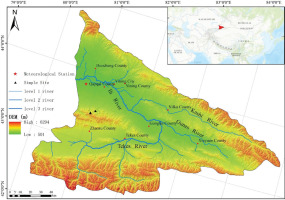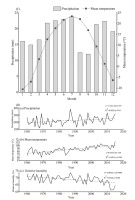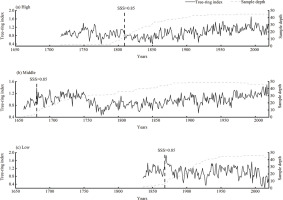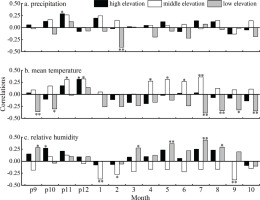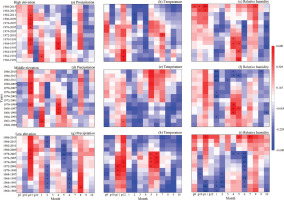. Introduction
Since the late 1970s, global warming has increased aridity in many continental regions, putting additional stress on semi-arid forestsin particular (Dai, 2013; Ji et al., 2014). Due to global warming, northwest China's precipitation and temperature have risen substantially in recent years, changing the region's climate from warm-dry to warm-wet (Shi et al., 2006; Yao et al., 2016). Consequently, the ecological and physiological processes of forest ecosystems in the mountains of northwest China have been influenced by the recent climate change (Li et al., 2015).
Both the ecosystem dynamics in forests and changes in climate can be studied utilizing tree rings (Gou et al., 2012). Dendrochronological studies of tree-growth responses to climate factors and subsequent reconstructions of historical climate history have been carried out in various regions of the world (Büntgen et al., 2005; Shao, 2005; D’Arrigo et al., 2009; Chen et al., 2015). The growth of trees and how they respond to climate variability have received a lot of attention in relation to global climate change (Savva et al., 2006; Sang et al., 2007; Wu et al., 2015). Changes in tree growth and forest production may result due to climate change. In addition to the fact that such changes in tree growth are an ecological concern, an understanding of how tree growth responds to climate influences is a critical component of global climate-change research (Liang et al., 2006).
Mountains are regarded widely as excellent sensors of climate change, chiefly because of the complexity of mountain climate and topography and their interactions with each other. Thus, elevation is one of the factors said to have an important influence on mountain tree growth (Malanson et al., 2011; Wang et al., 2015a). It is generally believed that in arid and semi-arid mountain areas, precipitation in low-elevation areas and temperature in high-elevation areas are major factors influencing tree development. However, global warming has changed the current climatic conditions in the mountains. For example, Liang found in their study on Qinghai Spruce (Picea crassifolia Kom.) that, in the context of climate change, the radial growth of trees showed a high dependency on precipitation and air humidity (Liang et al., 2016). Jiao et al. (2015) used moving correlation functions to assess the growth–climate relationship's temporal stability and revealed that Larix sibirica exhibited positive sensitivity to temperature, which decreased throughout the growing season. As the Tian Shan region's most significant zonal forest vegetation, the Schrenk spruce forms the main part of the Tian Shan forest ecosystem. It is mainly distributed on the middle-low mountain-subalpine shady slopes, at an altitude of 1200–3500 m a.s.l. It has advantages such as possessing clear annual rings, a wide distribution and sensitivity to climate, which also makes Tian Shan an ideal area for tree-ring climate research. In a previous study, Huo et al. (2017) observed an association between Schrenk spruce's radial growth and climate factors at various elevations in the western Tian Shan Mountains, China. Jiao et al. (2016) analysed the radial growth of Schrenk spruce at different elevations and the response stability of the main climate factors using a moving correlation function in the east of the Tian Shan Mountains, China. However, there are few reports on the stability of the tree-ring growth–climate responses of Schrenk spruce at different elevations in the western Tian Shan Mountains in the background of global warming.
In this study, we have created chronologies based on the width of the tree rings of Schrenk spruce at three elevations of the western Tian Shan Mountains, examined the characteristics of the three chronologies and analysed how climate change is affecting the growth patterns of the trees in the western Tian Shan Mountains.
. Materials and Methods
Study Area
The study area is located in the Wusun Mountain in the west of Yili region, Xinjiang, China. The Wusun Mountain is a branch of the Tian Shan Mountains. It is one of the mountains that forms the Zhaosu Basin, having the characteristics of high mountains and a mid-temperate continental climate. This study is focused on the northern slope of the Wusun Mountain at an elevation of 2000–2810 m, which has rich vegetation. The slope of the Wusun Mountain is a perfect example of the vertical distribution of climate, topography and vegetation (Fig. 1).
Tree-Ring Data
In June 2020, the research team established sample sites at three elevations, a low forest site (2000–2100 m a.s.l.), a middle forest site (2500–2565 m a.s.l.) and an upper tree line site (2800–2810 m a.s.l.) (Table 1). Only trees free of obvious damage and illness were sampled to reduce the non-climatic impacts on tree growth. Typically, two cores were removed from each tree at a breast height (1.3 m) along the vertical and parallel slopes. For the increment core samples, 20–30 of the oldest and largest trees at each location were chosen. To collect climate data from sensitive trees and reduce non-climatic signals from nearby disturbances and also the competition between trees, trees were chosen subjectively. We gathered 145 cores altogether from 72 live Schrenk spruce.
Table 1.
Tree-ring sampling point information.
All of the cores were put in hardwood boards with slots and polished in the laboratory until the annual ring limits could be clearly seen. With the LINTAB measurement system, the width of each tree ring was measured with a resolution of 0.001 mm (TM5, Rinntech, Heidelberg, Germany). The computer program COFECHA was used to verify the quality of all measured tree-ring sequences (Holmes, 1983). We employed autoregressive modelling to mitigate the autoregressive properties in the series and subsequently merged the processed data to generate a chronology by calculating the biweight robust means, which minimised the influence of outliers (Cook and Kairiukstis, 2013). In total, 130 cores were left for additional analyses after any ambiguous cores were eliminated. Using the ARSTAN program's established standardisation methodologies, we created site chronologies (Cook, 1985). To reduce the noise from individual trees, the standardisation method averages the detrended ring widths of all the series at a site and removes the non-climatic variability from each tree-ring series (Fritts, 2012). The tree-ring width series were detrended using a negative exponential approach to remove the signals of tree ages that were influenced by causes other than climate (Liu et al., 2010). The effectiveness of the replication in the early years of the chronology can be evaluated using the subsample signal strength (Wigley et al., 1984). Therefore, to provide a trustworthy chronology length, a subsample signal strength of >0.85 was applied.
Climatic ′Data
The Qapqal Meteorological Station (43°48′N, 80°47′E, 1060 m a.s.l.) of the National Meteorological Information Centre (NMIC) of China provided the mean monthly temperature, precipitation data and relative humidity information for the 1960–2015 time frame. Being the closest meteorological station and there were no missing values, we utilised to work with this station.
Numerous dendroclimatological studies have emphasised time and time again that the influence of climate on tree-ring development varies depending on the climatic region, with effects not only during the growth season but also in the time leading up to it (Heinrich et al., 2013; Opała and Mendecki, 2013). Therefore, in this study, the climate data from September of the previous year to October of the current year were selected for the response analysis with the chronology. According to the meteorological data records, the annual average temperature in this area is 11.30°C and the annual temperature difference is large. The average temperature in January is −10.63°C, compared with 23.38°C in July, and the annual precipitation is 225.86 mm. The summer precipitation reaches the annual precipitation peak, and the rain and heat occur in the same period (Fig. 2).
Statistical Analysis
With the use of Pearson's correlation tests, the association between the tree-ring chronologies (Fig. 3) and the mean monthly temperature, precipitation, and relative humidity was examined.
Table 2.
Statistical features of tree-ring width standardised chronology at different elevations.
Using the sliding correlation function in the Dendroclim2002 program, the dynamic changes of the relationship between the tree-ring chronology and each meteorological factor were analysed (the sliding window was set to 30 years, and each sliding was 1 year).
The standardised chronology information of tree-ring width at different elevations can be obtained from Table 2. The percentage of the first eigenvector indicates the synchronicity of each sample sequence in the chronology. The larger the percentage of the first eigenvector, the stronger the synchronisation of the sample sequence and the more the climate information contained in the chronology. The percentage of the first eigenvector of the three chronologies ranged from 0.285 to 0.451, and the synchronisation was generally good. The signal-to-noise ratio is the noise ratio between the climatic signal and the non-climatic signal factors (Gou et al., 1999). In other words, the chronology with a high signal-to-noise ratio contains more climate information, and the chronology with low-elevation tree-ring width is the largest among the three chronologies. The representativeness of the samples to the population all exceeded the minimum threshold of 0.85, which shows that the chronology of the three sampling points can represent the basic characteristics of the growth of Schrenk spruce in the study area (Wigley et al., 1984). The first-order autocorrelation coefficients of the three chronologies ranged from 0.589 to 0.653, demonstrating that the radial growth of trees at the three elevations was significantly affected by the previous year.
. Results and Analysis
Correlation between Tree-Ring Width and Meteorological Factors at Different Elevations
In the investigation of the relationship between the chronology of tree-ring width and the meteorological variables at each elevation, precipitation in November of the previous year was strongly positively linked with the tree-ring width chronology at high elevation, and precipitation in February of the present year was strongly negatively linked with the tree-ring width chronology at low elevation. In the correlation analysis with the average temperature, the key finding was a strong positive association between December of the previous year and the tree-ring width chronology at high elevation; the tree-ring width chronology at mid-elevation had a significant positive correlation with November–December of the previous year and April–July of the current year; the tree-ring width at low elevations had a significant negative correlation with September–October of the previous year and July–October of the current year. In the correlation analysis with relative humidity, the main results were that the tree-ring width chronology at high elevation had a significant positive correlation with October of the previous year, the tree-ring width at mid-elevation had a significant negative correlation with January–February and September of the current year and the tree-ring width at low elevation had a significant positive correlation with September of the previous year and March, May and July–August of the current year (Fig. 4).
Sliding Correlation Analysis of Climatic Variables at Various Heights and Tree-Ring Width Chronology
The sliding correlation between the tree-ring width chronology and meteorological factors at different elevations showed that the response of tree radial growth to precipitation at the three sampling points fluctuated. After 1976, the sensitivity of the radial growth of trees at the three sampling sites to precipitation in November of the previous year increased. During the period 1986–2015, high elevation and low elevation were not significantly correlated with precipitation, and middle elevation showed a significant positive correlation. The significant negative correlation between precipitation and low elevation in February of the current year increased, weakened after 1974 and changed to a significant negative correlation after 1982. In the sliding correlation with temperature, the main manifestation is that low elevation has a significant positive correlation with September–December of the previous year in 1968–1974 and with May–June of the current year in 1972–1978. In the sliding correlation with relative humidity, the main manifestation is a significant positive correlation between high elevation and September–November of the previous year after 1984, an enhanced significant negative correlation between middle elevation and January of the current year and a general weakening of the significant negative correlation of low elevation to relative humidity (Fig. 5).
. Discussion
Response Analysis of Tree Radial Growth and Meteorological Factors at Different Elevations
Elevation has important effects on tree radial growth through hydrothermal differences. Precipitation at low elevation is typically thought to be the main limiting element of tree radial growth, while temperature at high elevation is generally thought to be the main limiting factor. (Wilson and Hopfmueller, 2001; Yuan, 2003; Li et al., 2006; Solomina et al., 2012; Zhang et al., 2012; Chen et al., 2013; Solomina et al., 2014; Wang et al., 2015b; Zhang et al., 2016a,b, 2017a,b, 2019, 2020). The radial growth of trees at high elevation showed a significant positive correlation with the meteorological factors from October to December of the previous year. With the process of climate warming, climatic complexity increases along elevation gradients, so that tree radial growth may respond in different ways or to a different extent at different elevations (Lyu et al., 2016, 2017). So, the meteorological factors are exerting a highly critical influence on the radial growth and dynamic evolution of high-elevation forest trees (Liang et al., 2016; Jiang et al., 2017; Yang et al., 2017; Peng et al., 2019). Meanwhile, there is abundant precipitation in the Yili area of Xinjiang, China, and the hydrothermal combination in some areas is relatively complex. Therefore, it is challenging to identify the primary climatic conditions that limit the radial growth of trees (Zhang et al., 2016c).
The radial growth of trees at mid-elevation was mainly affected by the significant positive correlation between the average temperature in November and December of the previous year and the average temperature in April–July of the current year. There was a significant negative correlation effect of relative humidity in January, February and September of the current year. There was a certain difference between mid-elevation and high–low elevation, which may be due to the difference in the response patterns of mid-elevation and high–low elevation due to the difference of the largest precipitation zone in the middle of the forest, local small terrain or the microclimate (Shirenna et al., 2020). Under the condition of sufficient water, a higher temperature is beneficial to the photosynthesis of plants and promotes the growth of trees.
The relative humidity reflects the moisture content in the air (Xu et al., 2013). It affects tree growth by affecting water evaporation, vegetation transpiration and photosynthesis. In this study, the relative humidity promoted the radial growth of trees at high and low elevations. The radial growth of Schrenk spruce at high and low elevations is mostly constrained by water conditions, while the radial growth of trees at mid-elevation is mainly limited by temperature. Furthermore, the same results have been obtained in other studies in the Tian Shan mountains (Shirenna et al., 2020).
Dynamic Response of Tree Radial Growth at Different Elevations to Climate Change
In the context of global warming, the dynamic response of forests to climate change has become an important issue for scientists. By analysing the sliding correlation between the radial growth of spruce trees and the meteorological factors at different elevations, it can be concluded that there was an unstable response relationship between the radial growth of Schrenk spruce and meteorological factors at different elevations. Similar results have been reported in the Southern Appalachian Mountains, European Mediterranean Basin, Qilian Mountains, Northeast Tibet Plateau and Tian Shan Mountains (Zhang and Wilmking, 2010; Gao et al., 2013; Tegel et al., 2014; White et al., 2014; Jiao et al., 2015). Fig. 2 shows that there was an escalating trend in both precipitation and temperature, but that the evaporation rate caused by the increase in temperature was much larger than the precipitation increase, and the area showed a warm and dry trend. With the increase in temperature, water stress is the principal barrier to tree radial growth. From September to November of the previous year, the growth of trees stopped, but they could still carry out a certain amount of photosynthesis. The period's humid weather was favourable for the buildup of photosynthetic products and promoted the rapid growth of the early wood of trees. The significant increase in temperature accelerated the evaporation of water, gradually increasing the limiting effect of water on trees. That is to say, the relative humidity from September to November of the previous year was positively correlated with the radial growth of trees, and there was a significant increasing trend.
The sliding analysis of mid-elevation tree-ring chronology and meteorological factors mainly indicated an unstable relationship with precipitation and relative humidity, and the correlation was generally better than that of temperature. In the background of climate warming, the weakened temperature response to tree radial growth in the context of climate warming may be caused by the reduced temperature limitation and the associated water stress due to apparent warming. The correlation between tree-ring width and relative humidity and precipitation was stronger than that with temperature, which supports the conclusion that temperature-driven water budget changes are more important to the radial growth of Schrenk spruce than the effect of temperature on physiology itself (Liang et al., 2016).
. Conclusion
The tree-ring chronology at different elevations contains abundant environmental information, and the correlation analysis between the tree-ring width chronology at each elevation and meteorological factors showed that the radial growth of high-elevation trees was mainly affected by the meteorological factors in the non-growth season of the previous year. The radial growth of mid-elevation trees was mainly affected by temperature. The radial growth of low-elevation trees was mainly affected by both temperature and relative humidity. In the study area, the radial growth of Schrenk spruce mainly fluctuated in response to precipitation and relative humidity, while the radial growth of Schrenk spruce at low elevation was unstable in response to temperature. Climate change, especially in the background of climate warming, caused rapid warming in the study area resulting in enhanced evaporation. The resulting intensification of drought may have negatively influenced the radial growth of Schrenk spruce at low elevations, but moderate warming is expected to lead to increased radial growth of Schrenk spruce at high and mid-elevations. In future tree-ring research, it is necessary to detect the response stability of tree growth and meteorological factors to ensure the accuracy of climate reconstruction and to pay more attention to the relationship between climate change and forest ecosystems.
